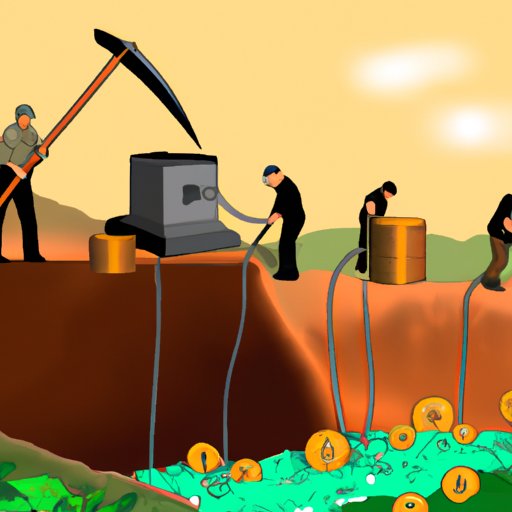Introduction
Bitcoin is one of the most popular cryptocurrencies today, and it has become a valuable asset for many people. But what exactly does mining for bitcoin mean? In this article, we’ll take a closer look at the process of Bitcoin mining and explore the different types, economics, and technical aspects. We’ll also examine the environmental impact of Bitcoin mining and discuss the benefits and risks associated with it.

A Guide to the Different Types of Bitcoin Mining
When it comes to mining for Bitcoin, there are three main types: cloud mining, pool mining, and solo mining. Each type has its own distinct advantages and disadvantages, so let’s take a closer look at each.
Cloud Mining
Cloud mining is a process in which individuals rent out computing power from companies that specialize in cryptocurrency mining. This allows users to mine Bitcoin without having to purchase or maintain any hardware themselves. The main benefit of cloud mining is that it eliminates the need for expensive hardware and setup costs. However, there are some drawbacks to cloud mining, such as the fact that it can be difficult to verify the legitimacy of cloud mining companies and their services.
Pool Mining
Pool mining is a process in which multiple miners join forces to increase their chances of solving a block and earning rewards. By pooling their resources, miners can share the rewards more evenly among participants. While pool mining is a great way to increase earnings, it also requires users to trust the pool operator to distribute rewards fairly. Furthermore, pool mining can lead to a decrease in rewards due to the increased competition.
Solo Mining
Solo mining is a process in which miners attempt to solve a block on their own. This is the riskiest option since it requires users to have powerful hardware and a reliable internet connection. However, if successful, solo miners can reap the highest rewards since they don’t have to share them with anyone else. Additionally, solo mining is the only way to ensure that all rewards are received by the miner.

Exploring the Economics of Bitcoin Mining
In order to understand the economics of Bitcoin mining, it’s important to understand the concepts of mining difficulty and block rewards. Mining difficulty is a measure of how difficult it is to solve a block, and it is adjusted by the network regularly to maintain the average time between blocks at 10 minutes. Block rewards are the rewards miners receive for solving a block, and they are currently set at 12.5 BTC per block.
Additionally, miners are also rewarded for processing transactions. Transaction fees are paid by users when they make a transaction, and miners receive a percentage of these fees for including the transaction in a mined block. The amount of fees miners receive varies depending on the number of transactions included in a block.

Explaining the Technical Details of Bitcoin Mining
The technical details of Bitcoin mining involve several different components. First, miners must have access to specialized mining hardware. This hardware is specifically designed to solve the mathematical equations required to mine Bitcoin. Furthermore, miners must also have access to mining software, which helps them manage their hardware and track their progress. Finally, miners must also have a good understanding of blockchain technology, which is the underlying technology behind Bitcoin.
Examining the Environmental Impact of Bitcoin Mining
The environmental impact of Bitcoin mining cannot be ignored. Mining for Bitcoin requires a lot of energy, which can lead to an increase in electricity costs. Furthermore, the waste heat produced by mining hardware can be damaging to the environment. Finally, the process of mining for Bitcoin can also lead to air and water pollution, as well as land degradation.
Conclusion
Mining for Bitcoin can be a profitable endeavor, but it also has its risks and challenges. It’s important to understand the different types of mining, the economics of mining, and the technical details involved. Additionally, it’s important to consider the environmental impact of Bitcoin mining and weigh the benefits against the risks. With all of this in mind, it’s up to each individual to decide whether or not mining for Bitcoin is right for them.
(Note: Is this article not meeting your expectations? Do you have knowledge or insights to share? Unlock new opportunities and expand your reach by joining our authors team. Click Registration to join us and share your expertise with our readers.)
